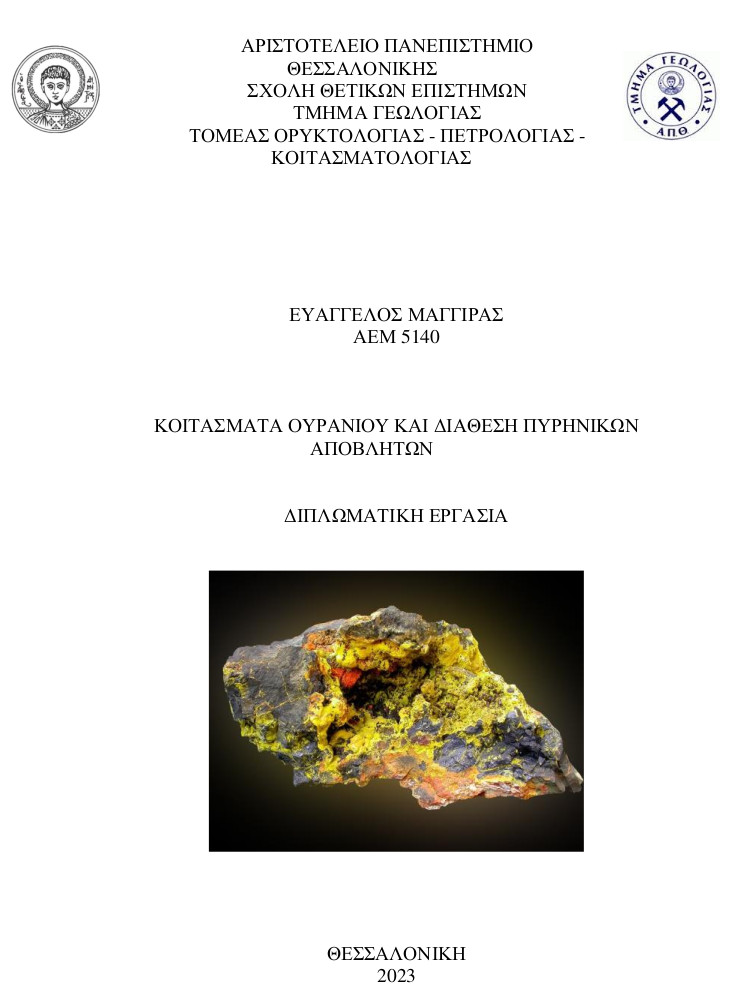
Κοιτάσματα ουρανίου και διάθεση πυρηνικών αποβλήτων = Uranium deposits and nuclear waste disposal.
Περίληψη
This diploma thesis focuses on the study of the element uranium (U), its deposits in global scale and the waste disposal management. Uranium is a radioactive element used from people for many decades. The deposits of exploitable uranium are spread all over the world and the types of those deposits are diverse. Large deposits can be found in Kazakhstan, Russia, Australia, Africa and Canada. Nuclear wastes can be from unconcerned up to extremely radioactive and so their collection and disposal should be extremely cautious and under precise procedures in order to minimize the hazard.
Πλήρες Κείμενο:
PDFΑναφορές
Dahlkamp, F. J. (2013). Uranium ore deposits. Springer Science & Business Media.
Meija, J., Coplen, T., Berglund, M., Brand, W., De Bièvre, P., Gröning, M., Holden, N., Irrgeher, J., Loss, R., Walczyk, T. & Prohaska, T. (2016). Atomic weights of the elements 2013 (IUPAC Technical Report). Pure and Applied Chemistry, 88(3), 265-291.
Morss, Lester. "uranium". Encyclopedia Britannica, 21 Feb. 2021,
Albert V. Crewe, Enrico Fermi Institute, University of Chicago Albert V. Crewe, Enrico Fermi Institute, University of Chicago
Dahlkamp, F. J. (1993). Principal Aspects of the Genesis of Uranium Deposits. Uranium Ore Deposits, 41–56.
Geology of Uranium Deposits - World Nuclear Association. (n.d.). World Nuclear Association. Retrieved April 2, 2022, from https://world-nuclear.org/information-library/nuclear-fuel-cycle/uranium-resources/geology-of-uranium-deposits.aspx
Lambert,I., McKay, A., and Miezitis, Y., Australia's uranium resources: trends, global comparisons and new developments, Bureau of Resource
Sciences, Canberra (1996), with their later paper: Australia's Uranium Resources and Production in a World Context, ANA Conference October 2001
McKay, A., and Miezitis, Y., Australia’s Uranium Resources, Geology And Development Of Deposits, Geoscience Australia (2001), ISBN 0642467161
Laverov et al. 1992c, Petrov et al. 2000, Poluarshinov and Pigulski 1995
Giannardi, C., & Dominici, D. (2003). Military use of depleted uranium: assessment of prolonged population exposure. Journal of environmental radioactivity, 64(2-3), 227–236.
UNEP BTF, 1999. The potential effects on human health and environment arising from possible use of depleted uranium during the 1999 Kosovo conflict. A preliminary assessment. United Nation Environmental Program Balkan Task Force, Geneva
World Health Organization. (2001). Depleted uranium : sources, exposure and health effects. World Health Organization. https://apps.who.int/iris/handle/10665/66930
NEA/IAEA (2019), Uranium 2018: Resources, Production and Demand, OECD Publishing, Paris
Dahlkamp F.J. (2009) Part II: Uranium in Asia – Overview. In: Dahlkamp F.J. (eds) Uranium Deposits of the World. Springer, Berlin, Heidelberg.
Ziegler, V., Dardel, J. (1984). Uranium deposits in Europe. In: De Vivo,Springer, Dordrecht.
Young, R.G. (1984). Uranium deposits of the world, excluding Europe. In: De Vivo, B., Ippolito, F., Capaldi, G., Simpson, P.R. (eds) Uranium geochemistry, mineralogy, geology, exploration and resources. Springer, Dordrecht.
Central and South America. In: Dahlkamp F.J. (eds) Uranium Deposits of the World. Springer, Berlin, Heidelberg (2010).
Yim, MS. (2022). Introduction. In: Nuclear Waste Management. Lecture Notes in Energy, vol 83. Springer, Dordrecht. https://doi.org/10.1007/978-94-024-2106-4_1
Commission on Isotopic Abundances and Atomic Weights (1999)
Office of Nuclear Material Safety and Safeguards U.S. Nuclear Regulatory Commission, Interagency Steering Committee on Radiation Standards (ISCORS):1999 Annual Report
Effects of cationic substitutions and alteration in urinite, and implications for the dating of uranium deposits, Sibbald and Quirt (1987)
Εισερχόμενη Αναφορά
- Δεν υπάρχουν προς το παρόν εισερχόμενες αναφορές.
